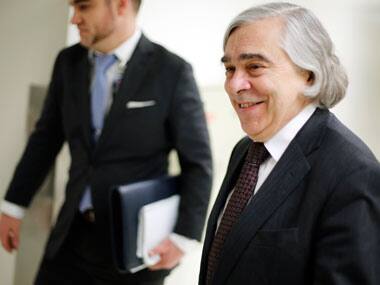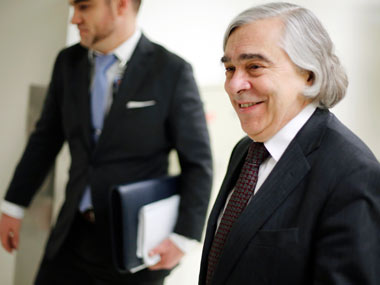New York: US Energy Secretary Ernest Moniz will travel to India on a two-day visit for the resurrected bilateral energy security dialogue on 10 March which earlier became a casualty of L’Affaire Khobragade. Nuclear physicist Moniz, a longtime faculty member at the Massachusetts Institute of Technology, became energy secretary in May last year. He was due in Delhi on 15 January for the energy dialogue but his trip got scuttled last month due to the bad blood over the diplomatic row. Energy-hungry India is looking to increase natural gas in its energy mix and will urge Moniz to greenlight liquefied natural gas (LNG) exports, arguing it would be an economic benefit to both nations. A spike in US natural gas production in recent years thanks to shale development has led to a supply surplus while India’s domestic supply has dwindled, leaving it scrambling for new supply deals. [caption id=“attachment_1383641” align=“alignright” width=“380”]  Moniz was due in Delhi on 15 January for the energy dialogue but his trip got scuttled last month due to the bad blood over the diplomatic row. Reuters[/caption] Amid the emergence of the US as an energy superpower, India is looking to America as a new source for imports. In a good sign, state-run energy giant Gail India Ltd. has managed to lock down a 20-year import deal to buy liquefied natural gas, from Houston-based Cheniere Energy. New Delhi is now pressing Washington to relax its restrictive export policy for other Indian companies. Washington doesn’t allow gas exports to any country with which it doesn’t have a Free Trade Agreement, but it is making an exception for India’s Gail. In a deal worth some $15 billion, Houston-based Cheniere Energy will supply GAIL with 3.5 million tonnes per year of LNG from Cheniere’s Sabine Pass LNG terminal in Louisiana. At current prices, it’s a favourable deal for India and LNG deliveries are expected to start in 2017. Prime Minister Manmohan Singh has ranked the signing of the civil nuclear energy deal with the US as the “best moment” of his 10-year term as India’s premier. However, visiting energy secretary Moniz will remind the PM that five years after the landmark agreement not a single US nuclear company has been able to make significant headway, adversely impacting the strategic partnership. A big idea unfulfilled can lead to disillusionment as with the two countries’ civil nuclear deal. So far we have only seen a pre-early works agreement between Westinghouse and state-run Nuclear Power Corporation of India (NPCIL) that would pave the way for construction of an AP-1000 nuclear power plant in Gujarat. The preliminary deal with Westinghouse does not involve putting in place nuclear equipment, so will not brush up against the liability issue. The preliminary contract between Westinghouse and NPCIL would be limited in scope to site assessments. A final contract will still take years as both sides still have to resolve the problem that has dogged nuclear negotiations: India’s 2010 Nuclear Liability Act that hands American companies large financial liabilities in the event of an accident. The diplomatic row led to the postponement of not only Moniz’s visit to India but other high-level visits by US officials, including one by Nisha Desai Biswal, the US Assistant Secretary of State for South and Central Asia. India blamed the US for what it called a “mini crisis” over the arrest and strip search of its deputy consul general in New York in December and said more work was needed to repair ties. India curbed privileges bestowed on US diplomats in retaliation and asked Washington to withdraw a diplomat from New Delhi in response to Khobragade’s expulsion from the US. Moniz’s trip to India is a sign that both sides are now working to contain lasting damage from what has turned into the biggest rift in years. There is no doubt India will take time to forgive and forget. “India gains far more from closer ties with the US than it loses, not just in terms of government-to-government, military or trade relations, but in the people-to-people contacts and immigration flows that have underpinned a great deal of innovation in the Indian economy. To fall into a fit of pique at perceived US arrogance is short-sighted and counter-productive,” wrote Nisid Hajari in Bloomberg. Bilateral trade in goods grew to $59.1 billion last year through November, up 57 percent from $37.6 billion for all of 2009, according to data from the US Census Bureau. The US is the fifth-largest source of foreign direct investment into India, according to the Indian Embassy.
Amid the emergence of the US as an energy superpower, India is looking to America as a new source for imports.
Advertisement
End of Article


)

)
)
)
)
)
)
)
)



